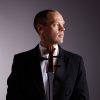
The Holy Sextet (Part 2)
Brant Taylor
Part 1 began an exploration of three bow variables that—in addition to the three well-known concepts of weight, speed, and contact point—make up a sextet of basics that should be known and practiced to maximize your control over the string with the bow. We discussed the first and most important, bow angle, in Part 1. The remaining two variables may seem relatively minor, but they are by no means unimportant. If practicing means attempting to find solutions to the challenges of successful instrumental control, you should attempt to understand every potential reason for success or failure with the bow.
FLATNESS OF HAIR, or how much of the hair makes contact with the string.
Many cellists hold the bow with the stick tilted up (toward the fingerboard) to some degree. This means that the stick does not track directly over the hair, and also that you are often using only part of the hair on the bow to play. Sure, this technique may be deliberate sometimes—for example, when you want to play very softly or achieve a particular flautando color—but I’ve noticed that using the full hair from frog to tip in cello playing is the exception. Should this be the case? I’ve been lucky to sit a few feet away from Pinchas Zukerman as he’s played violin and viola concerti through my years with the Chicago Symphony Orchestra. I’ve long admired his sound, and have noticed that he uses flat hair all the time.
Some players might point out that even with the stick tilted up, the hair is full anyway because the heavy weight of the arm flattens it out. This may be true at the frog, but it is almost never true at the tip, resulting in bow strokes where the hair use is inconsistent: flat at the frog moving to some fraction of the hair approaching the tip. Can this be good for consistency of tone throughout the length of the bow? Playing with flatter hair increases your control of the string, especially at the beginnings of notes and especially on the thicker lower strings. Practice starting notes at the tip on the C string in both loud and soft dynamics. Try it with flat hair and then with the bow tilted away from flat hair. The difference is often striking.
TENSION OF HAIR, or how tight the bow is when you play.
Do you aim to tighten the bow the same amount whenever you play? Do you achieve that? Even small variations in hair tension can have an effect on how the bow performs and feels on the string. Keep checking the tension throughout a practice session, rehearsal, and even a performance to make sure it is what you want. And further, explore the idea that the same tension may not be ideal for everything you play. Each bow and every bow arm is different, so you must answer for yourself whether the Shostakovich Concerto and a Bach Gamba Sonata call for the same bow tension. In strokes like spiccato, the behavior of the bow can be dramatically different depending on how tight the hair (and, therefore, the stick) is. My own experience has often led me to loosen my bow a fraction for many slow movements and other music where legato is desired and I want to feel an especially “buttery” contact with the string. In any case, experimenting with this relatively minor variable can only lead us to a more informed place and greater consistency of execution of the many bow skills you aim to master.
Subjects: Practicing, Technique
Tags: Bach, bow, bow strokes, Brant, Brant Taylor, cellists, cello, cellobello, Chicago Symphony Orchestra, Concerto, contact point, CSO, frog, Pinchas, Shostakovich, success, Taylor, Technique, variables, weight, Zukerman
